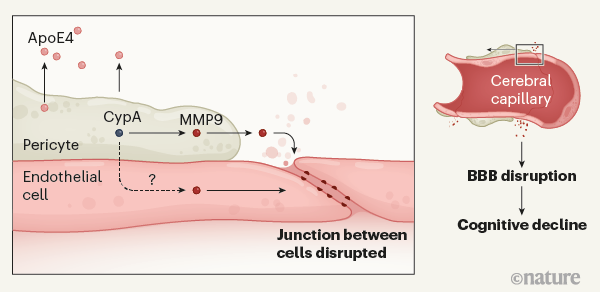每日外闻91
Risk factor for Alzheimer’s disease breaks the blood–brain barrier
阿尔茨海默症的危险因子打破了血脑屏障
携带ApoE4基因突变的人患老年痴呆症的风险高于平均水平。研究表明,这种突变与血脑屏障缺陷以及随后的认知能力下降有关。
阿尔茨海默症最著名的标志是聚集在大脑中的成簇的错误折叠的淀粉样蛋白β(Aβ)和tau蛋白。然而,人们越来越意识到Aβ和tau可能不是故事的全部——血脑屏障(BBB)的改变也成为这种神经退行性疾病的早期征兆。 BBB的破坏程度与一个人经历的认知功能障碍的程度相关,但是导致BBB故障的原因尚不清楚。 Montagne等在《自然》杂志上发表的研究表明,阿尔茨海默氏病的主要遗传危险因素载脂蛋白E4与血脑屏障的故障有关。
载脂蛋白E (ApoE)基因在大脑中编码一种主要的载脂蛋白ApoE。ApoE主要有三种突变:ApoE2、ApoE3和ApoE4。与几乎所有的基因一样,人们携带两种ApoE拷贝,它们可能是相同的突变,也可能是不同的突变。与更常见的ApoE3突变相比,ApoE4可显著增加患阿尔茨海默病的风险,携带一个ApoE4拷贝的人患病风险可增加4倍,携带两个ApoE4拷贝的人患病风险可增加15倍。携带APOE4的阿尔茨海默病患者也比不携带APOE4的患者更早出现病症。
The best-known hallmarks of Alzheimer’s disease are clumps of misfolded amyloid-β (Aβ) and tau proteins, which aggregate in the brain. However, there is increasing awareness that Aβ and tau might not be the whole story — alterations in the blood–brain barrier (BBB) have also emerged as early markers of this neurodegenerative disorder. The degree of disruption to the BBB correlates with the degree of cognitive dysfunction that a person experiences, but what causes BBB breakdown has been unknown. Writing in Nature, Montagne et al. present evidence that the leading genetic risk factor for Alzheimer’s disease, apolipoprotein E4, is linked to BBB breakdown.
The gene apolipoprotein E (ApoE) encodes a major lipid-carrier protein, ApoE, in the brain. There are three predominant variants of ApoE: ApoE2, ApoE3 and ApoE4. As with almost all genes, people carry two copies of ApoE, which can be either the same or different variants. Compared with the more-common ApoE3 variant, ApoE4 markedly increases the risk of Alzheimer’s disease — up to 4-fold in people with one copy of this variant, and 15-fold in people who have two copies. People carrying ApoE4 who do contract Alzheimer’s disease also tend to develop symptoms of the disorder earlier than those who develop the disease but do not carry the variant.
See you tomorrow











